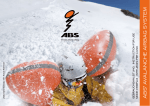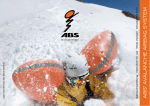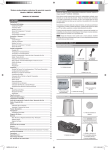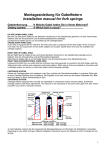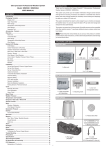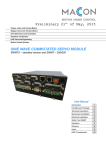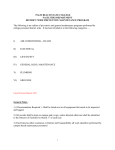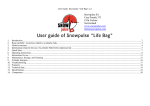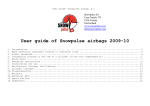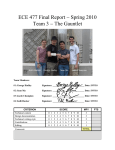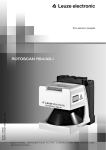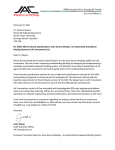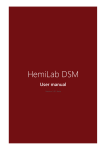Download User Manual
Transcript
Table of Contents 1. Welcome . . . . . . . . . . . . . . . . . . . . . . . . . . . . . . . . . . . 20 2. Warning Notices and Appropriate Use . . . . . . . . . . . . 21 3. Unit Description and Parts . . . . . . . . . . . . . . . . . . . . .22 4. Operation 4.1. Initial Operation and practice activation . . . 22 – 28 4.2. During each tour or operation of the system . . . . 28 4.3. At the end of each tour . . . . . . . . . . . . . . . . . . . . 28 5. Handling during Avalanche Incident 5.1. Activation . . . . . . . . . . . . . . . . . . . . . . . . . . . . . . 29 5.2. Handling yourself during the avalanche . . . . . . . 29 5.3. After the avalanche . . . . . . . . . . . . . . . . . . . . . . . 29 5.4. Questionnaire for statistical analysis . . . . . . . . . 29 6. How it Works . . . . . . . . . . . . . . . . . . . . . . . . . . . 29 – 30 8. Components 8.1. Airbags . . . . . . . . . . . . . . . . . . . . . . . . . . . . . . . . 31 8.2. Suction and release valve . . . . . . . . . . . . . . . . . . 31 8.3. Puncture unit . . . . . . . . . . . . . . . . . . . . . . . . . . . 31 8.4. Activation handle . . . . . . . . . . . . . . . . . . . . . . . . 32 8.5. Cartridge . . . . . . . . . . . . . . . . . . . . . . . . . . . . . . 32 8.6. Carrying system . . . . . . . . . . . . . . . . . . . . . . . . . 32 9. Storage and Cleaning . . . . . . . . . . . . . . . . . . . . . . . . . 32 10. Transport . . . . . . . . . . . . . . . . . . . . . . . . . . . . . . . . . 33 11. Working Life . . . . . . . . . . . . . . . . . . . . . . . . . . . . . . . 33 12. Additional Information 12.1. Troubleshooting . . . . . . . . . . . . . . . . . . . . 34 – 35 12.2. Warranty . . . . . . . . . . . . . . . . . . . . . . . . . . . . . . 35 12.3. Technical data . . . . . . . . . . . . . . . . . . . . . . . . . 35 12.4. Permits / Conformance . . . . . . . . . . . . . . . . . . . 36 12.5. Service Centers . . . . . . . . . . . . . . . . . . . . . . . . 36 7. Maintenance 7.1. Self-check . . . . . . . . . . . . . . . . . . . . . . . . . . . . . 30 7.2. Post-avalanche check . . . . . . . . . . . . . . . . . 30 – 31 7.3. Customer service . . . . . . . . . . . . . . . . . . . . . . . . 31 English 19 1. Welcome Congratulations on your purchase of the ABS Avalanche Airbag System. 20 For the functioning of the ABS Avalanche Airbag you need an activation unit (cartridge + handle). In order to ensure your proficiency you can conduct a practice activation at your retailer. This manual provides you with information about the function and use of the ABS Avalanche Airbag System. It applies to every out of bounds snow sport enthusiast. Please read the user manual before you practice your first activation by pulling the activation handle. It is imperative that you fill out the accompanying warranty card and send it back to us. Your warranty claim will then be extended to 4 years. Please read this manual carefully before you use this equipment. Pay special attention to the warning notices and strictly adhere to the information within. In order to be able to easily consult this user manual we suggest that you keep it in a convenient location. Make sure you include it if you choose to pass this equipment on. Do not attach the activation handle to the ABS-System unless you have attached a full cartridge first. Always change the activation handle and cartridge after an activation of the system! Only when both parts have been changed is the system ready to use again. Remove the acti-vation handle when airbag is not in use. Sections in the manual that are marked with this symbol identify risks which, if not observed will lead to serious consequences. Always use the ABS Avalanche Airbag System in combination with an avalanche transceiver, shovel and probe. The ABS-System is Made in Germany. The ABS Avalanche Airbag System is an emergency equipment, which under certain conditions can prevent a total burial if activated. It cannot prevent the release of an avalanche. An element of deadly risk remains even if the user doesn’t get buried. Every avalanche is absolutely life threatening regardless of any equipment. Therefore the ABS Avalanche Airbag System should not encourage you to take greater risks. English 2. Warning notices and appropriate use The ABS Avalanche Airbag cannot prevent an avalanche. Every avalanche is always absolutely life threatening, with or without an ABS Avalanche Airbag. The ABS Avalanche Airbag should not in any way increase your willingness to take risks. The function and action of the ABS-System is limited solely to preventing the total burial of an avalanche victim. However, there may be situations when this is only partially or not at all possible. The ABS-System has to be activated. It is important to practice this in order to be able to react properly in case of emergency. For your own safety you should practice the activation once a season. The ABS-System requires careful handling and proper inspection before each use. Activation handle and cartridge are refillable. Only attach the activation handle if a full cartridge has been attached. Activation without a cartridge or with an empty one will damage the system and render it non-functional. It will have to be sent in for inspection. If the red line is clearly visible the activation handle is not charged and therefore not functioning! Do not use damaged handles as there is a danger that they could burst while releasing! Do not try to pull the pin outside the brass quick coupler located at the backpack strap – risk of injury. It is essential that the pin is protected from dirt. Should the pin have come in contact with dirt, do not clean it yourself. Send it to your respective service center for an exchange instead. Pay attention to the expiry date of the release handle. Only use original ABS cartridges, refills, parts or spares. Do not manipulate the system. The cartridge should screw in easily right to the back stop. If you experience any resistance or if it is really hard to turn the cartridge right up to the back stop, then this cartridge cannot be used! The full cartridge cannot be exposed to heat (stove, sun etc.). Do not throw or stress the cartridge. Risk of explosion! Max. temperature is 50ºC (+122 F). When packing the airbags make sure that nothing can damage the airbags and that the airbags are able to open up freely. This applies especially to attachable parts like ice picks, poles, skis, etc. Fold the airbags according to the instructions. Improper folding inhibits the opening of the airbags, can lead to malfunctioning and damage the backpack. Keep children away from the ABS System. Be careful not to endanger other people when practicing the activation of the airbag. In order to avoid an unwanted or inadvertent activation when other people could be harmed by such an accidental activation, it is recommended that you remove the handle, especially on chairlifts, in gondolas, in the helicopter, the bus, train, etc. English 21 3. Unit description and Parts Please unfold picture page 4. Initial Operation 4.1 Initial operation and practice release 1) Puncture unit 2) Airbags 3) Airbags compartment 4) Suction and release unit 5) Release valve The uncompromising functioning and the personal handling by the user of the ABS Avalanche Airbag System are critical. The handling is straightforward but must be done with care and according to the steps outlined below: Step 1 22 6) Plastic flap 7) Brass quick coupler 8) Handle plate 9) Chest strap 10) Waist belt 11) Leg strap Checking the cartridge weight Check the weight of the cartridge without the cartridge cap before each use. The weight is listed on the bottom or the side of the cartridge. Tolerance limit +/- 5 grams (0.18 oz). Your retail shop will exchange any cartridge with a weight that differs more than the tolerance limit at no charge. A completely full cartridge is an absolute prerequisite for the proper functioning of the ABS Avalanche Airbag. 12) Cartridge 13) Cartridge cap 14) Activation handle 15) Pin English Step 2 Step 3 Attaching the cartridge Attaching straps and belts Check if the puncturing unit is clean before attaching the cartridge. The piercing pin must be visible in the middle. Screw in the full cartridge right up to the back stop and tight enough that there is no possibility of another turn. Put the backpack on and adjust shoulder straps to fit your body. Always fasten waist belt, chest and leg straps and fit them according to your body. The ABS-System will only be of use to you if the backpack stays on your body during an emergency! Check that the cartridge is screwed in tightly before each use of the airbag to avoid leakage and malfunctions. Most of the weight of the pack should be resting on your hips rather than being carried by your shoulders. The carrying system meets the TÜV guidelines for extreme operational demands. The tensile strength for all weight bearing straps equals 3000 N (674lbf). It should be easy to screw in the cartridge right up to the back stop. Make sure that the cartridge doesn’t get screwed in on an angle. If you experience any resistance or if it is really hard to turn the cartridge right up to the back stop, then this cartridge cannot be used! Your retail shop will exchange the cartridge at no charge. Tip! Put on your backpack before you attach the activation handle. This way you avoid an unwanted or inadvertent activation. On the Escape Freeride model 4 l the puncturing unit for the cartridge is located in the zippered pocket inside the right airbag compartment. Make sure to close the zipper after attaching the cartridge. On the 10 l Freeride model the puncture unit for the cartridge is located in the main compartment behind the zipper. English 23 Step 4 The pin has to be firmly fixed and the red line should not be visible. If the red line is visible on the pin, the handle has not been charged and therefore will not function properly! Checking the activation handle The activation handle is charged with a small pressurized capsule, which contains 0.19 grams of explosives. It can therefore only be unsed once. By pulling the attached activation handle the pressurized capsule explodes. The resulting pressure punctures the cartridge and the airbags are filled. Do not use damaged handles as this might cause it to burst during the activation function. Do not try to pull the pin outside of the brass quick coupler – risk of injury! The pressurized capsule functions for a limited time only. We therefore do not recommend the use of unused cartridges after 3 winter seasons. 24 Protect the handle from contamination! Always store the handle away from children! The metal pin on the side opening of the release handle indicates the maximum operating time. Please observe the following expiry dates: silver-colored metal pins Expiry date May 2010 For the wireless activation handle please consult the special instruction manual. black metal pins Expiry date May 2012 gold-colored metal pins Expiry date May 2013 Unused, expired release handles can be exchanged for a fee. English Step 5 Step 6 Attaching activation handle Velcro closure In order to attach the activation handle, align the pin with the brass coupler and push the handle in. With the other hand flip up the plastic flap, thus administering counter pressure. The brass coupler will automatically snap back. The Velcro closure secures the activation handle in order to avoid unwanted activations. Before you leave a patrolled area, the red Velcro closure must be completely loosened and attached behind the activation handle to facilitate an unhindered activation. A tightly fastened Velcro usually prohibits an activation. Only then is the handle attached properly and ready to use. If the handle will not attach refer to point 12.1. If the handle is not attached properly and is stuck due to the coupler snapping back into place, a proper activation will be impossible. Attention! Only attach the handle if a full cartridge has been screwed in. When activating without a cartridge or with an empty one, the system will be damaged and the pin must be exchanged. Please direct all queries to your respective Service center. If you followed all the steps up to this point your ABS-System is now operational. However, we recommend that you finish studying the instruction manual before you conduct your practice activation. 25 In order to completely eliminate unwanted activations we recommend that you remove the activation handle. Particularly in situations when you could endanger yourself and other people such as on chairlifts, in gondolas, in the helicopter, the bus, train, etc. For the wireless activation handle please consult the special instruction manual. English Step 7 Step 8 Height adjustment of the activation handle Remove activation handle Check when wearing the backpack if the activation handle is positioned in a way that works for you. Usually that is the case, if not, the handle attachment can be adjusted to the appropriate height. The proper position of the activation handle should be between chest and shoulder. In order to adjust the height open In order to remove the handle, undo the Velcro closure and push the coupler upwards. The activation handle will pop out without you pulling on it. Do not pull the charged activation handle, the system will be activated! If you are not able to remove the activation handle refer to point 12.1. Remove the handle when ABS backpack is not in use and store it in the pocket located at the hip strap. 26 Step 9 and undo the Velcro closure, attach the handle plate to the appropriate plastic grommet and fasten the Velcro closure. Make sure that the activation handle is not obstructed by clothing and that it can be easily reached. A retail shop will be able to attach the activation handle on the right hand strap if so desired by left-handed clients. A special handle plate is therefore needed. Practice activation We want you to feel 100% comfortable with the ABS-System. Therefore you are able to conduct a practice activation and experience the action of the ABS-System as close to real conditions as possible at your retailer at no cost. Please ensure that during the practice activation the distance to people and objects is approximately 1 m (3.28 feet) in order to avoid adverse affects. Activate the handle with a strong, rapid pull. English The required activation force equals approx. 8 kg (17.64 lb; 80 N). The airbags will inflate within 2-3 seconds. Step 11 Folding airbags Please make sure to perform the yearly practice activation in order to retain the extended warranty (see item 12.2). Attention! Background noise after inflation is caused by the release valve, which automatically equalizes the pressure. The inflation of the airbags varies according to the outside temperature and elevation. Attention! Improper folding will result in poor opening of the airbags. This can lead to malfunction and damage to the backpack! 1 Therefore please fold the airbags according to the following instructions. 1. Always put the airbags on the ground with the suction and release valve facing down. The smooth side of the airbag faces you. Step 10 Deflate airbags Push the release valve (flip up red cover, push red button in the center of the black suction and release unit) and compress the airbag while emptying completely. Attention! Only deflate when there is no longer any avalanche danger! 2. Fold the top edge of the airbag towards you. The top fold of the airbag should be at the height of the airbag compartment. 3. Fold the lower part of the airbag towards you so that the height of the lower edge of the airbag is in line with the airbag compartment. English 27 2 3 Step 12 4. Fold the airbags in an accordion manner from the inside to the outside (away from the backpack), one hand width wide so that they can unfold freely Replace cartridge and activation handle After every activation the cartridge and the activation handle must be replaced. Proceed according to step 1, 2 and 4, 5. The ABS-System is then once again operational. 4 5. Now push the airbags in the designated compartments. The suction and release valve must be clearly visible on top of the airbag material. Proceed now with the practice activation and complete the online form in order to extend the warranty (www.abs-airbag.com under ABS-System). 4.2 During each tour or operation of the system 28 5 Follow steps 1 - 6 of the Initial Operation 1 Checking cartridge weight 2 Attaching cartridge 3 Attaching straps and belts 4 Checking activation handle 5 Attaching activation handle 6 Velcro closure 4.3 At the end of the tour 6. Fasten the Velcro closures of the airbag compartments tightly. Follow step 8 Removing activation handle of the Initial Operation. The cartridge can remain attached. 6 English 5. Handling during avalanche incident 5.3 After the avalanche 5.1 Activation Find a safe place. Try to help other victims if possible. Only deflate the airbags when there is absolute certainty that there is no longer any danger of avalanches and attach another cartridge and activation handle immediately if possible. In case you are still in an avalanche prone area, leave the airbags inflated. Activate the ABS Avalanche Airbag without hesitation as soon as you become aware of an avalanche. It is better to activate once too often than not at all. In order to activate pull hard and fast on the activation handle and try to escape. The airbags are self inflating, independent of whether you are skiing, are falling, are lying on top of the airbag or are already captured by the moving snow. The inflated airbags will not compromise your possible escape or avoidance of rocks etc., which you should always try to do. 5.2 Handling yourself during the avalanche Once you have activated, only concentrate on your fall line. The way that the airbags are attached on the sides of the pack allows you to freely move your arms. Fight by swimming and pushing away obstacles. Try to steady yourself and protect your head. The shape of the airbags will help to protect your head without compromising your movements and ability to see. Try to twist out of your ski bindings. Never put your hands through the pole straps and never use safety straps with your bindings. If possible keep your mouth closed. When the avalanche is coming to a halt, try to keep your upper body and arms above the snow and free yourself from the avalanche as soon as possible. 5.4 Questionnaire for statistical analysis Please report each activation you had to perform with your ABS Avalanche Airbag. The Federal Institute for Snow and Avalanche Research in Davos (Switzerland) conducts a central statistic. The findings from actual activations are very important for the further development of the system. You can request the Questionnaire directly from us or download it from our website. If you have been in an avalanche and activated your system we will replace your cartridge and activation handle at no charge if you fill out and sign the avalanche-questionnaire and send it to your respective service center. 6. How it works With the ABS Avalanche Airbag you have purchased a device based on many years of experience in avalanche research, rescue and statistics. Led by the one outstanding fact, that a predominant number of all avalanche victims (skiers and snowboarders) are still alive when the avalanche comes to a halt. However, most of them are buried, are unable to free themselves and are often not visible to the rescuer. And this is where the race with death begins and is lost by those victims, who are totally buried and have blocked airways. English 29 The main obstacle for a successful rescue is when the burial depth is one meter or more. Often the time it takes to shovel these victims out of such snow depths exceeds their survival time. Therefore it is absolutely vital to prevent a burial as good as possible. One pull of the activation handle and within seconds the ABS Avalanche Airbag provides the physical prerequisites for this to happen. The moving snow flushes large volume objects to the surface. If these objects have a smaller dimensional weight then the surrounding snow, they will stay at the surface. 30 The additional airbag volume of 170 liters helps that you will stay on top of the moving snow. The weight, shape as well as the attachment of the airbags, also contribute to this. A large surface area combined with a flexible attachment that fits close to the body convert the flow force into buoyancy. The ABS Avalanche Airbag System has already prevented hundreds of snow enthusiasts from being buried. 7. Maintenance 7.1 Self check • The ABS Avalanche Airbag is maintenance free if the following points are observed. • Unfold both airbags at least once a year. We also recommend a yearly practice activation, preferably at the beginning of the season. The activation can easily be practiced on a safe site. • Check the release valve in the black suction and release unit. Push the red button several times. It has to completely click back into place each time. • Inspect the condition of the backpack straps, buckles, airbag compartments and Velcro closures on a regular basis. • Check whether the puncturing unit which holds the cartridge is free of dirt • The activation handle should easily fit into the coupler. You can add a drop of ABS oil to the coupler if you have problems removing the handle. A sample tube of ABS oil is included and can be ordered from ABS. • Make sure that the full cartridge is screwed in tightly each time before using the ABS Avalanche Airbag. 7.2 Post-avalanche check Every use can negatively affect the material. Often the damage is not visible with the naked eye. We therefore recommend sending the ABS-backpack and empty cartridge to your service centre for a prophylactic inspection. Please send the filled out questionnaire to be used for statistical analysis of avalanche accidents to us or the Swiss avalanche institute (see item 5.4). English If you are unable to send the ABS Avalanche Airbag in right away we recommend to check the following: – check the airbags visually for punctures – check the airbag fastening straps for tears – check the shoulder, waist and chest straps as well as the seems for tears – check all buckles (adjustment buckles at the shoulder straps, waist and chest strap) – check buckles as well as leg straps for tears and deformation In any case send the ABS Avalanche Airbag System to your respective service center for inspection. 7.3 Customer service After three seasons the manufacturer recommends a general inspection. The ABS Avalanche Airbag including cartridge and activation handle have to be send to your respective service center. The ABS customer service will charge for this inspection. The customer service includes a much more extensive inspection of all ABS parts than the practice activation or self check. The appropriate ABS customer service for each of the countries is listed on our web page www.abs-airbag.com under contacts. 8. Components 8.1 Airbags Each of the two airbags has a volume of 85 liters when inflated. They are inflated simultaneously but have separate closure and suction valves. If one of the airbags is damaged the other one will remain inflated for a sufficient amount of time. The inner pressure equals approx. 0.1 bar. 8.2 Suction and release valve This combination part is attached directly to the airbag. The button for the release valve is located in the middle of the black suction and release unit. It is protected from unwanted pressure by a red plastic cover. 8.3 Puncture unit The puncture unit into which the cartridge is screwed into is housed in a compartment at the top of the backpack. Make absolutely sure that it stays clean and that no objects can damage it. Therefore always close the cover. A screwed in cartridge can be unscrewed from the puncture unit at any time. Only the pull on the attached handle will activate the cartridge. We generally recommend to always leaving the cartridge attached. English 31 32 8.4 Activation handle 8.6 Carrying system The activation handle is equipped with a blank cartridge. By attaching the handle to the coupler at the shoulder strap of the backpack and then pulling the activation handle, the blank cartridge will ignite. The explosion pressure travels through the tube to the puncture unit. There a cartridge containing nitrogen will be pierced with the pin and the nitrogen is forced through the pressure tubes to the two airbags where in combination with the suction and release valve the airbags get inflated. Inflation time is approx. 2 – 3 seconds! The authorized carrying systems are identified by the ABS logo. The various straps and belts comply with the TÜV requirements for extreme operational demands. The tensile strength for all weight bearing straps equals 3000N (674lbs). In order to ensure that the ABS Avalanche Airbag System stays on the person’s body during an avalanche, it is imperative that the waist belt, chest strap and leg straps are properly fastened. Otherwise there is no guaranty that the ABS Avalanche Airbag will stay on your body during an avalanche. 8.5 Cartridge 9. Storage and cleaning The cartridges contain only harmless gas, the same as in our air. The inside pressure is 300 bar (Carbon cartridge 340 bar). The piercing of the cartridge should only occur within the puncture unit of the ABS-system. Any manipulation at the closure or at the cartridge can trigger an explosion. High risk of injury and death, even for bystanders. Make sure before each use that the full cartridge is screwed in tightly and check the weight as described in steps 1 and 2 of the Initial Operation. Otherwise you can leave the cartridge attached. Each cartridge is designed for temperatures from -40ºC to +50ºC (-40F to +122 F). Empty cartridges can only be filled by ABS. The exchange can only be done at an ABS retail shop. Avoid impacts such as dropping the cartridge. Depending on the model, the cartridges comply with the following guidelines: – Steel cartridge Europe: EG guidelines – Steel cartridge North America: DOC and TC certified – Carbon cartridge: EG, DOT and TC certified Always make sure that the protective cap is on the cartridge when the cartridge is not attached to the airbag. It is recommended to remove the handle after each use. The ABS Avalanche Airbag should be stored in a dry, rodent free area and away from children. Use only soapy water to clean the airbag or the backpack. Do not use harsh cleaning agents like bleach or OxiCleaner. Do not wash in a washing machine. Protect the suction and release valve from water and other liquids. Attention: after cleaning make sure that the system is completely dry before use – risk of freezing. English 10. Transport 11. Working Life Generally you are allowed to take your airbag on the airplane. The guidelines are outlined in the IATA (International Air Transport Association) reference guide under dangerous goods Table 2.3A. However, you have to register the ABS-Airbag with your airline 14 days before your departure. For each ABS-pack you are allowed 2 activation units with the activation handle not attached. By adhering to the manufacturer recommended maintenance schedule of 3 seasons, the working life mainly depends on the degree of usage and mostly refers to the backpack. When using the system according to the instructions and on an average of 50 days per season, the ABS-System (not the backpack) can be expected to function for 10 years. It is important to perform the suggested practice activation by activating the ABS System once year. We strongly recommend that you request the IATA guidelines from your respective service center or that you download them yourself from our website in order to be able to show them at the ticket counter. We also recommend that you put the copy of the IATA guidelines along with your cartridge, activation handle and backpack in your carry-on luggage. If you are traveling within the USA you need to comply with FAA rules. If the backpack / carrying system shows signs of wear and tear it is possible to transfer the ABS Avalanche Airbag into a new backpack/carrying system or into the Freeride pack. The transfer will be carried out by the manufacturer. Please contact your respective service center for more details. If there is any damage to the carrying system, the buckles or the airbag itself is damaged, by a puncture for example, the system must be exchanged. When you transport the cartridge outside the airbag the protective cap must be on the cartridge. Please use the original box for both the cartridge and the handle. English 33 34 12. Additional information Malfunction Troubleshooting 12.1 Troubleshooting The charged activation handle does not come off – You must leave the full cartridge in place – Gently push the coupler upwards, wiggle the handle from side to side and carefully try pulling it down – In addition apply a drop of ABS oil to the handle and turn it to increase lubrication – If this doesn’t work the system has to be sent in for service The airbags are difficult to remove from the compartments and are hard to inflate – Were the airbags folded properly? – Did the weight of the cartridge match the filled weight? – If you answered both with yes you have to send the airbag in for service – If you are unsure about either one of these points, perform a practice activation – If the problem persists send the ABS-System in for service Malfunction Troubleshooting I pulled the activation handle without the cartridge – the undamped explosion pressure will damage the or with an empty cartridgesystem and render it unuseable and must be repaired – Direct all queries to your respective service center Activation handle does not attach – Put a drop of ABS oil into the coupler. Push up coupler, attach and remove handle several times until the coupler is functioning properly – If this doesn’t work the system has to be sent to your respective service center – Do not try to attach the handle with force – If you are out in the field and you have no ABS oil with you, push the coupler up, attach the handle and then push the coupler down English Malfunction Troubleshooting 12.3 Technical data After inflating the airbags there is a definite background noise – This noise is due to the release valve equalizing the pressure – After a few minutes the pressure drop should not be clearly visible any more – If the pressure drop is still clearly visible, the system needs to be repaired. Send the ABS-System in for service Volume of airbag: Weight of system: Release: Filling procedure: Cartridges: 12.2 Warranty To extend your warranty of the ABS-System from 2 years to 4 years please complete the warranty card on-line no later than 30 days after your purchase (www.abs-airbag.com under ABS-System). (The ABS-System does not include the backpack). Carrying system: It is required to successfully perform the practice activation according to steps 1-12 of the instructions for use and to continue self-testing the unit year after year. Operating temperature: English 2 x 85 liter airbags Approx. 1200g Pyrotechnical ignition in the activation handle Within approx. 1 second 90 liters (23,8 US gallon) of a gas-air mix is forced into the two airbags while the remaining approx. 80 liters (21,1 US gallon) will take 1.5 seconds (depending on outside temperature and elevation). Are made from highly durable materials with an allowable pressure of more than 300 bar (4400 psi). Depending on the model, the cartridges comply with the guidelines of the EG or DOC / TC for North America. Complies with the TÜV requirements for extreme operational demands. The tensile strength for all weight bearing straps equals 3000 N (674lbf). From -40ºC to +50 ºC (-40F to +122F) 35 36 12.4 Permits and conformance 12.5 Service centers Manufacturer: ABS Peter Aschauer GmbH Country of origin: Germany The ABS customer service centers for the different countries are listed under contact on our website www.abs-airbag.com Type: ABS Avalanche Airbag System ABS Peter Aschauer GmbH An der Dornwiese 3, D-82166 Gräfelfing Tel.: +49-89-8987890, Fax: +49-89-89878960 E-Mail: [email protected], www.abs-airbag.com The nature of the materials and the kind of workmanship used for the development of the ABS Avalanche Airbag System are based on the standard values of comparable usage requirements. These standard values form the requirement profile for the material and operating tests conducted by TÜV Süd Product Service GmbH within the Federal Consumer Product Safety Act, according to PPE directive 89/686 EWG as well as the CE guidelines. Yet during an avalanche incident there could be forces and circumstances, which will exceed these standard values. We would therefore explicitly point out that the ABS Avalanche Airbag System in its entirety and in parts (airbag material, attachments, backpack, etc.) cannot withstand all possible demands which will arise during an avalanche incident. TÜV Süd Product Service GmbH, Ridlerstr. 21, D-80339 München, Prüfstellennummer 0123. Die ABS Peter Aschauer GmbH is a certified company according to ISO 9001:2000 standards. The ABS System is Made in Germany. English


















